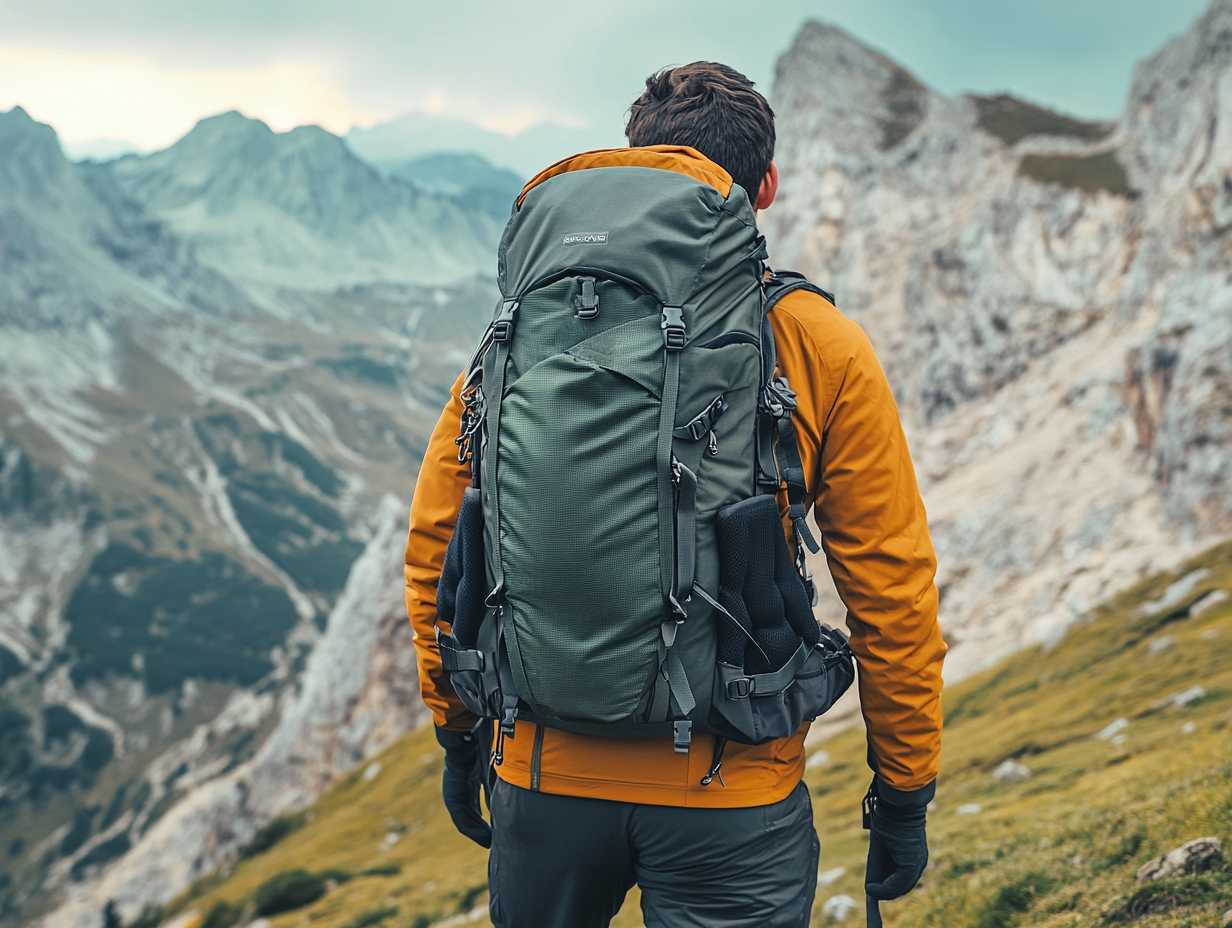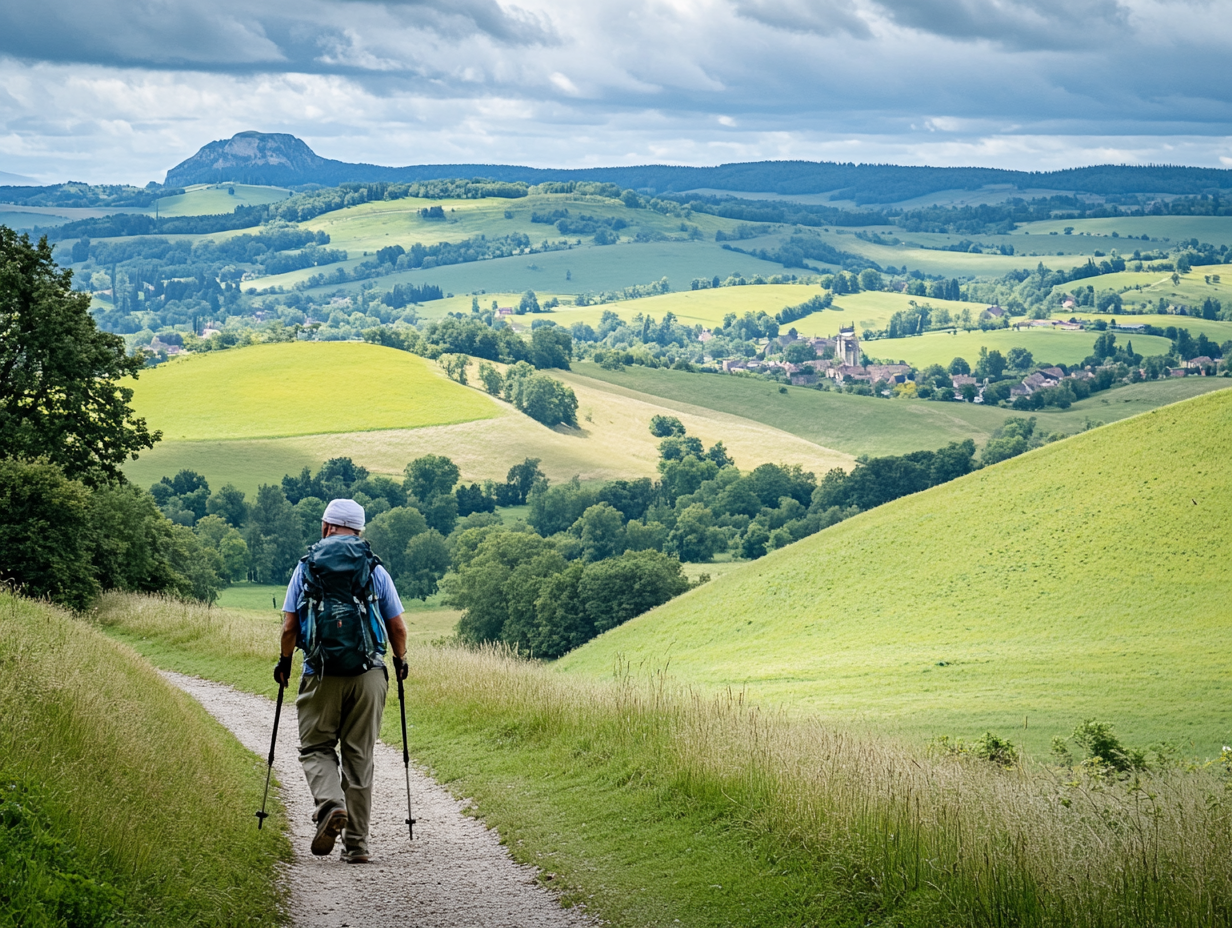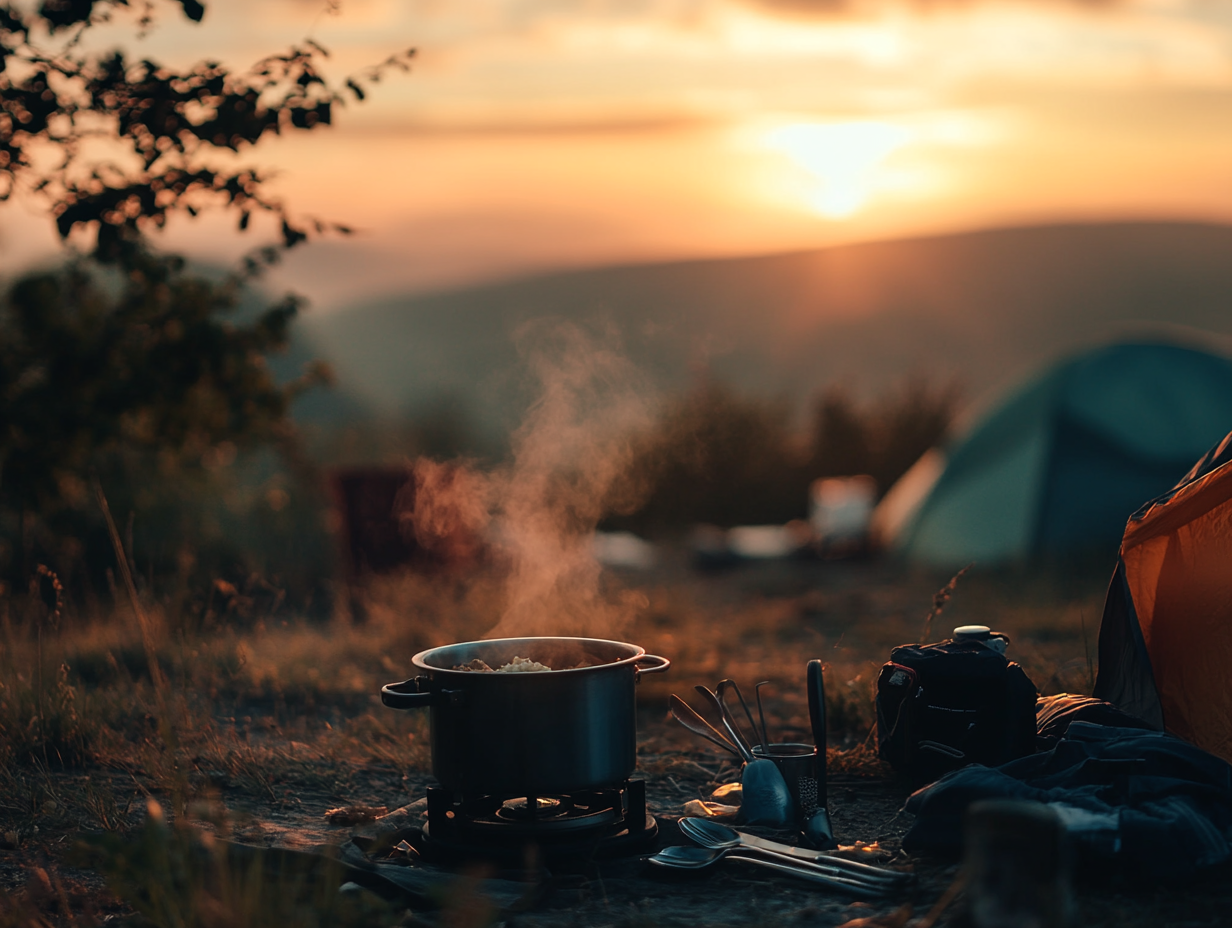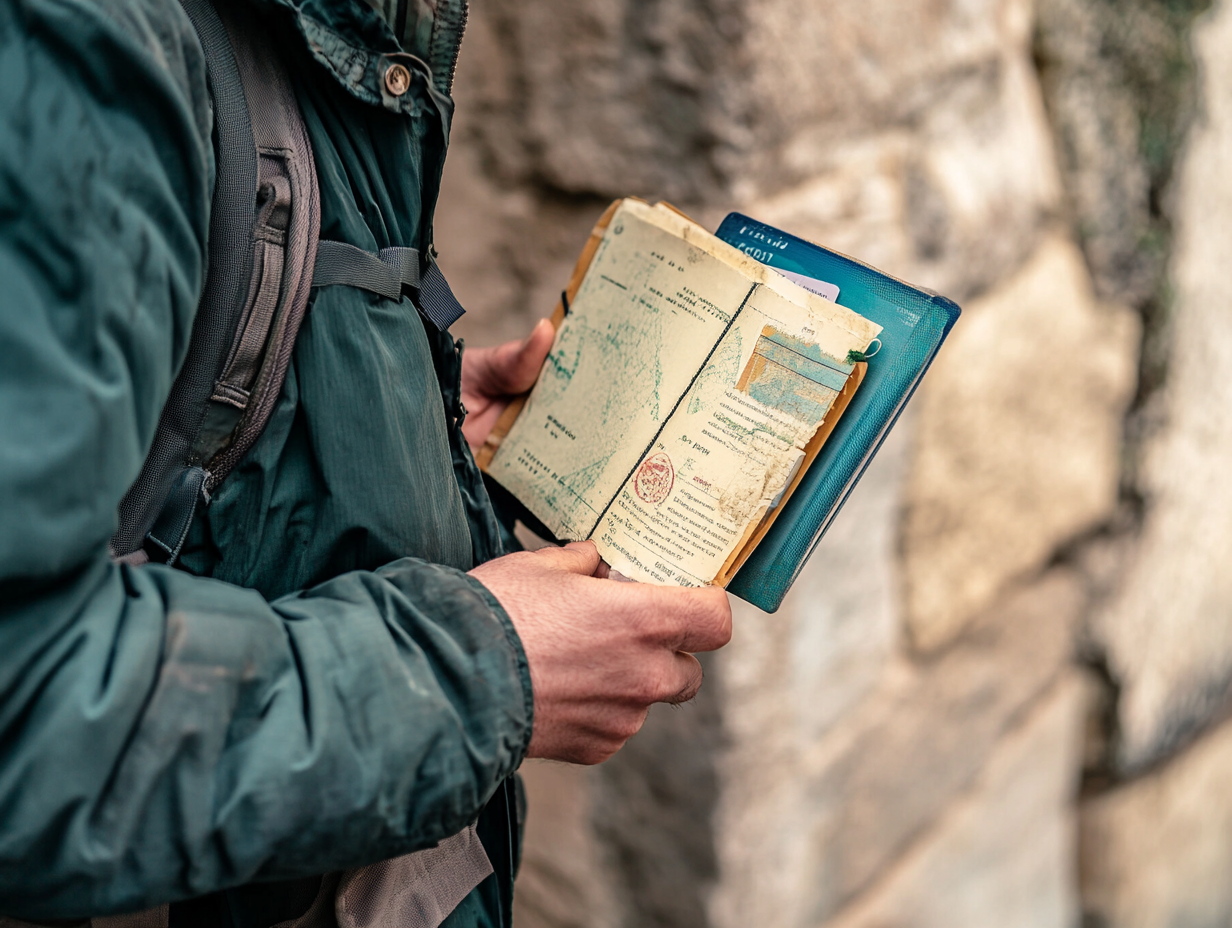October 1, 2024
Camino de Santiago Ultimate Packing List 2025
Discover the ultimate Camino de Santiago packing list for 2025. Get essential tips to pack light and stay comfortable on your pilgrimage.

Packing for the Camino de Santiago is about finding the right balance. You need to carry enough to be comfortable and prepared, but your backpack shouldn't be too heavy. For most people, 7-8kg (without water or food) is a good target. This weight offers comfort without being too heavy, making your journey easier on your back and feet. Of course, if you feel strong, you can carry more, and if you prefer to keep it lighter, you can pack less.
This guide will show you how to pack what you need without overpacking.
In a hurry? See the full checklist here
Backpack: How to Choose the Right One

The backpack you choose is very important for your Camino. A good backpack will make your journey much easier and more comfortable.
- Comfort & Fit: Make sure your backpack fits you properly. Visit an outdoor store where they can help you find the right size. A poorly fitted backpack can cause shoulder and back pain, which can ruin your walk.
- Hiking Backpack vs. Travel Backpack: It’s best to choose a hiking backpack rather than a regular travel bag. Hiking backpacks are designed to be comfortable for long distances, with good padding and support, especially around the hips and shoulders. This helps distribute the weight so your shoulders don’t carry it all.
- Capacity: A backpack that holds 30-40 liters is usually enough for the Camino, especially if you’re walking in warmer months. A bigger backpack might make you pack too much, which can be uncomfortable to carry.
- Features to Look For:
- Hydration System Compatibility: Your backpack should have space for a water bladder (like a Camelbak) or have side pockets for water bottles. Staying hydrated is very important, and having water within easy reach helps a lot.
- Hip Belt Pockets: These are handy for keeping small items like snacks, your phone, or sunscreen. You can grab them without taking off your backpack.
- Rain Cover: Make sure your backpack has a rain cover. Even if you’re walking in the summer, unexpected rain can happen. A rain cover will keep your gear dry, so it’s a must-have item.
With the right backpack, you’ll be much more comfortable, and you’ll avoid problems like sore shoulders or back pain.
Footwear: Your Most Important Gear

Your choice of footwear is probably the most crucial decision you'll make when packing for the Camino. If your feet aren't happy, neither will you be!
- Comfort & Fit: Your shoes must be comfortable and well broken-in. Walking long distances in new or poorly fitting shoes is a recipe for blisters and discomfort. If you have wide feet, consider shoes with a wide toe box to give your feet room to breathe and prevent blisters.
- Type of Shoes: Traditional heavy hiking boots with ankle support aren't always necessary. In fact, lightweight trail runners or sturdy walking shoes are often better because they allow your legs to move more naturally across different types of terrain. They also help avoid knee pain, which can happen if your shoes are too rigid.
- Multiple Pairs: It's important to bring two pairs of footwear. One pair should be your main walking shoes, preferably waterproof in case of rain. The second pair should be something comfortable for the evenings, like sandals or flip-flops. After a long day of walking, your feet will thank you for giving them some time to rest in lighter, more comfortable shoes.
- Socks: High-quality, moisture-wicking socks are essential. Merino wool socks are a great option because they help keep your feet dry and reduce the risk of blisters. Toe socks, which separate each toe, can also help prevent blisters caused by toes rubbing against each other. If you are particularly blister-prone, consider using liner socks under your main socks for added protection.
- Socks Care: Bring at least three pairs of socks so you can rotate them during your walk. Changing into a fresh pair during rest stops helps keep your feet dry and healthy. Always let your used socks dry by hanging them on your backpack or in your accommodation overnight.
By taking care of your feet, you will make your Camino experience much more enjoyable and avoid the discomfort that comes from sore feet or blisters.
Hydration and Nutrition Essentials

Water:
Staying hydrated is critical while walking the Camino, especially on long stretches where water refill points may be scarce.
- Water Capacity: At a minimum, carry 1 liter of water, but it's better to have the ability to carry up to 2 liters, especially on sections of the Camino where water stops are less frequent. Always know how long the stretch is before your next chance to refill.
- Hydration Systems: A water reservoir (like a Camelbak) is an excellent choice because it lets you drink without having to stop and take off your backpack. Having easy access to water is especially helpful when you’re tired and just want to keep moving. If you prefer bottles, make sure they are easily accessible in side pockets of your pack.
- Purification: Although the Camino is well-traveled and most routes offer plenty of water stops, it’s still a good idea to carry water purification tablets if you plan to walk in more remote areas or simply want to have peace of mind. They are small, lightweight, and can be a lifesaver if you find yourself without clean water.
Food:
While you don’t need to carry large amounts of food, it’s good to have a few snacks on hand to keep your energy up between meals.
- Snacks for the Day: Carry high-energy snacks like nuts, dried fruits, or energy bars to help you refuel during the day, especially if you’re walking long distances between towns.
- Lunch Reserve: Depending on the route, there may be stretches where it’s hard to find a place to buy food for lunch. In these cases, carrying a small, lightweight lunch like a sandwich or some easy-to-eat fruit is a good idea to avoid going hungry on the trail.
By managing your water and food wisely, you’ll be prepared for long stretches and avoid dehydration and fatigue.
Trekking Poles: Optional but Helpful

Trekking poles can be a great addition to your Camino gear, especially if you're walking on uneven terrain or steep hills.
Key Points:
- Usage: While not essential, trekking poles are particularly helpful on trails with lots of elevation, such as the Pyrenees. They help reduce the strain on your knees and provide extra stability during descents, making your walk more comfortable and safer.
- Adjustability & Weight: Choose poles that are lightweight and adjustable. This way, you can easily carry or pack them when not needed, and adjust the height for comfort while walking.
Sleeping: Where and How to Sleep

Sleep might be the most important thing in life, and on the Camino too! If you don’t rest well, you’ll feel it the next day—your physical condition will suffer, your mood might drop, and you won’t enjoy the Camino as much. Having the right sleeping setup is key to ensuring you’re well-rested and ready for the next stage of your journey.
What to Bring:
- Sleeping bag or silk sleep liner: For warmth and cleanliness in albergues, as blankets are not always provided.
- Inflatable or foam mattress: An inflatable mattress provides comfort and keeps you off the cold, hard ground. Foam mattresses are lighter and don’t require inflating but may offer less comfort.
- Small inflator: If using an inflatable mattress, an inflator is useful to avoid moisture from your breath getting into the mattress, which can reduce insulation and cause discomfort. It also saves energy after a long day of walking.
- Lightweight tent or hammock: A tent for outdoor sleeping, or a hammock as an alternative—easy to set up but offers less protection from wind and cold.
- Eye mask and earplugs: Essential for shared dorms to block out light and noise from other pilgrims.
Things to Consider:
- Albergues: Pilgrim hostels provide basic bedding, but sometimes lack blankets. A sleep liner or light sleeping bag is handy for extra warmth.
- Camping: If you plan to camp, a lightweight setup is key. Hammocks are great for easy setup, but be mindful of cold, windy conditions—bring layers or a good sleeping bag.
Cooking Equipment: For the Self-Sufficient Traveler

While it's not always necessary to cook your own meals on the Camino, if you're camping or prefer the flexibility, bringing your own cooking gear is important.
What to Bring:
- Compact stove: Small and lightweight, ideal for simple cooking.
- Gas canister: Ensure it's compatible with your stove and lightweight.
- Lightweight cookware: A pot, pan, or collapsible cup will cover most needs.
- Utensils: A spork or multi-functional utensil for eating and cooking.
- Basic food supplies: Snacks like nuts, dried fruit, energy bars, and small instant meals like soup or noodles.
Things to Consider:
- Albergues: Some hostels provide kitchen facilities but not cooking utensils, so it’s best to bring your own lightweight gear if you plan to cook.
- Cooking vs. Eating Out: Cooking gives you more control, but buying meals along the Camino can be easier and sometimes more cost-effective. Balance self-sufficiency with convenience based on your preferences.
Essential Accessories

These small accessories can make a big difference in your comfort and convenience during the Camino.
What to Bring:
- Phone: For GPS navigation, photos, communication, and emergencies.
- Headlamp: Ideal for nighttime activities or early morning walks, leaving your hands free.
- External battery: To keep your phone and other devices charged, especially in remote areas or hostels without enough outlets.
- Multi-tool (like Swiss Army knife): A small, lightweight multi-tool with a knife, bottle opener, scissors, and corkscrew.
Things to Consider:
- Charging: Ensure you have charging opportunities in hostels or bring a large external battery if you'll be camping.
- Phone usage: Download important maps, guides, or apps in advance to minimize data usage and ensure you’re prepared even if Wi-Fi isn’t available.
- Lightweight tools: Choose lightweight, multipurpose tools to reduce the load without losing functionality.
Toiletries & Hygiene

When you're walking the Camino, staying clean and fresh becomes essential for both comfort and health. Proper hygiene items will help you feel rejuvenated after long days of walking and ensure you’re ready for the next leg of the journey. Let’s go over the essential toiletries you should pack.
What to Bring:
- Towel: A lightweight, quick-drying microfiber towel or a linen towel, which dries fast and doesn’t retain odors.
- Soap & Toothbrush Kit: Bring a travel-sized soap, toothpaste, toothbrush, and disinfectant wipes to keep things hygienic and compact.
- Ear Cleaner (Oriculi): For keeping ears clean while minimizing waste compared to cotton swabs.
- Menstrual Cup (for women): An eco-friendly and convenient solution for the duration of the walk.
Things to Consider:
- Towel Choice: While microfiber towels are the lightest option, linen towels have the added benefit of being odor-resistant and fast-drying, especially useful after several days of use.
- Compactness: Pack travel-sized toiletries to reduce weight and space in your bag. You can always restock on the Camino if needed.
Clothing: Men’s and Women’s

Packing the right clothing can make your Camino experience far more comfortable, no matter the weather. The key is to bring versatile, lightweight, and moisture-wicking clothes that will help you stay cool during the day and warm during the evenings. Here’s what to pack for your walk.
What to Bring:
- Socks: 3 pairs of moisture-wicking socks (Merino wool recommended for durability, temperature regulation, and odor resistance).
- T-Shirts: 2-3 quick-drying, moisture-wicking t-shirts to stay comfortable while walking.
- Underwear: 3 pairs of quick-drying, moisture-wicking underwear to avoid chafing and discomfort.
- Walking Shorts: 1 pair of lightweight, quick-drying shorts for daytime walking.
- Comfortable Pants: 1 pair of lightweight pants for cooler days or evenings.
- Rain Gear: A lightweight, waterproof jacket or poncho for rain protection.
- Sun Protection: A sun hat and sunglasses to protect against sun exposure.
- Fleece or Hoodie: A lightweight fleece or hoodie for cooler mornings and evenings.
- Swimwear: If you're walking along routes near the ocean (like the Camino del Norte), bring a swimsuit for a refreshing swim after a long day of walking.
Women-Specific Items:
- Sports Bra: Bring 1-2 supportive, moisture-wicking sports bras for comfort on long walks.
Things to Consider:
- Layering: Pack clothing using the layering system—base layer for moisture-wicking, mid-layer for insulation (like a fleece), and an outer layer for protection (rain jacket or windbreaker). This gives you flexibility in changing weather.
- Seasonal Planning: Even in the summer, mornings and evenings can be cold, so bring layers. For winter, consider packing heavier clothing and gear for warmth.
- Merino Wool: This fabric is ideal for the Camino because it wicks moisture, regulates temperature, and resists odor better than synthetic materials.
- Religious Visits: If you plan on visiting churches or religious sites along the way, it's respectful to have more modest clothing. Avoid sleeveless tops, shorts, or skirts that are too short. Instead, have a lightweight, modest top and pants or a longer skirt ready for these occasions. However, most hiking clothes are generally acceptable.
First Aid Kit: Be Prepared

When walking the Camino, it's essential to have a first aid kit for minor injuries and common problems like blisters. Walking long distances each day can take a toll on your body, so it’s better to be prepared rather than risk discomfort or having to stop your journey.
What to Bring:
- Blister Care: Compeed blister plasters, moleskin, and foot powder should be part of every pilgrim’s first aid kit. These items are critical for preventing and treating blisters, one of the most common issues on the Camino.
- Survival Blanket: A lightweight survival blanket can be useful in emergencies or if you're stuck outside in cooler weather.
- Mini Multi-Tool & Scissors: Include a small multi-tool with scissors for cutting tape, moleskin, or bandages.
- Medical Tape & Safety Pins: Use medical tape for securing dressings or strapping up minor injuries, and safety pins are useful for various quick fixes, from holding things in place to drying clothes on your backpack.
- Elastic Bandage: Bring one elastic bandage for supporting sprains or strains, which can happen on the uneven paths.
- Sunscreen: A high SPF sunscreen is essential to protect your skin from long hours of exposure to the sun. Reapply throughout the day (every 2 to 4 hours) to prevent sunburn.
Things to Consider:
- Replenishing: If you run out of first aid supplies, you’ll find pharmacies along most Camino routes. Make sure to restock as needed.
- Foot Care: Taking care of your feet daily—by airing them out, switching socks, and using blister care products—will make a big difference in your comfort.
Documents: What to Bring for the Camino

Having the right documents with you is important for staying in albergues, proving your identity, and making sure you're covered in case of any emergencies. While walking the Camino, it's best to keep your documents easily accessible but safely stored.
What to Bring:
- ID or Passport: If you’re an EU resident, your national ID will work for most parts of the Camino. Non-EU residents will need a valid passport. Make sure it's up to date and valid for your entire journey.
- Camino Credential: The Credential del Peregrino (Pilgrim’s Passport) is needed for staying in pilgrim hostels (albergues) and for collecting stamps along the way. You’ll also need it to get your Compostela certificate at the end of the journey.
- Health Insurance Card: EU residents should bring their European Health Insurance Card (EHIC), which covers medical treatment within the EU. If you’re not from the EU, or just to be on the safe side, it’s a good idea to have travel insurance that includes medical coverage.
- Photocopies or Digital Copies: It’s smart to have photocopies or digital versions of your important documents (ID, passport, health insurance). Keep these copies separate from the originals or store them on a cloud service in case anything gets lost or stolen.
Things to Consider:
- Travel Insurance: Make sure your travel insurance covers medical issues, accidents, and possible delays or cancellations during your Camino.
- Storage & Safety: Keep your documents in a waterproof pouch inside your backpack. It might also be worth using a money belt or an inner pocket to avoid losing anything.
Optional but Helpful Extras

In addition to your essential gear, there are a few extras that can improve your Camino experience. While not necessary, these items can make your journey more comfortable and enjoyable.
What to Bring:
- Travel Lock: If staying in albergues, some provide lockers for valuables. A small travel lock is handy for securing your belongings, giving you peace of mind while you sleep or explore.
- E-reader (Kindle): A Kindle or similar e-reader can be great for reading during rest times or at night, without the bulk of carrying physical books.
- GPS Watch: While not essential, a GPS watch can be useful for navigation and tracking your daily distance. It’s helpful to see how much progress you’re making or how far you have left.
- Earbuds: Earbuds are great for listening to music, podcasts, or audiobooks while walking, or for relaxing in the evening.
- Small Journal & Pen: Many pilgrims enjoy keeping a journal to document their thoughts, reflections, and memories during their Camino. It’s a personal way to capture your journey and can be a nice keepsake.
Things to Consider:
- Balance Weight & Comfort: If you’re trying to stay light, assess which extras are really necessary for you. While some items like a travel lock can offer peace of mind, others like a Kindle or journal might be more of a personal preference.
- Charging Devices: If you bring electronics like an e-reader or GPS watch, don’t forget your charger. Having a small power bank or extra battery might also be useful.
Conclusion: Packing smart for the Camino de Santiago
Packing for the Camino is all about balance—bringing what you need without overloading yourself. Stick to the essentials, prioritize comfort, and remember that staying light will make your journey more enjoyable. With the right gear and preparation, you'll be ready to fully embrace the experience of walking the Camino de Santiago.